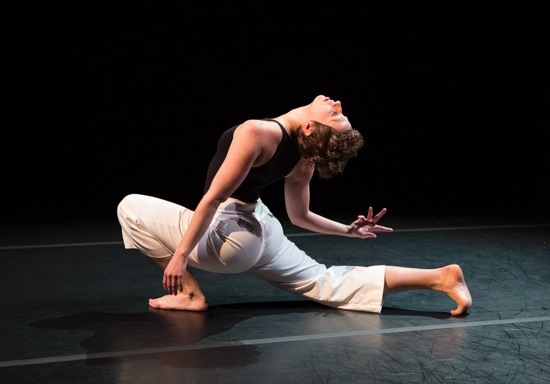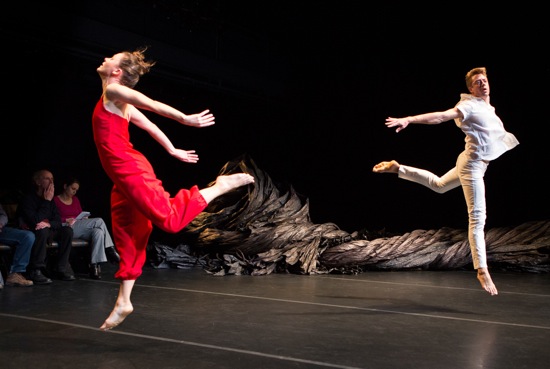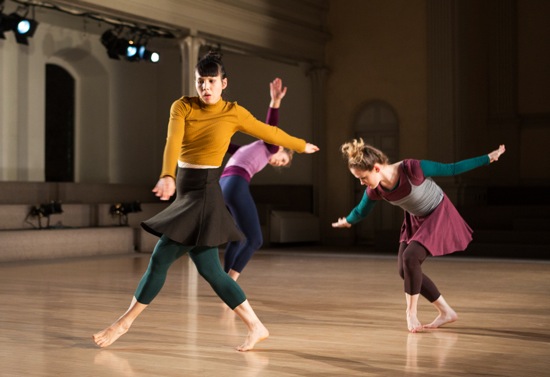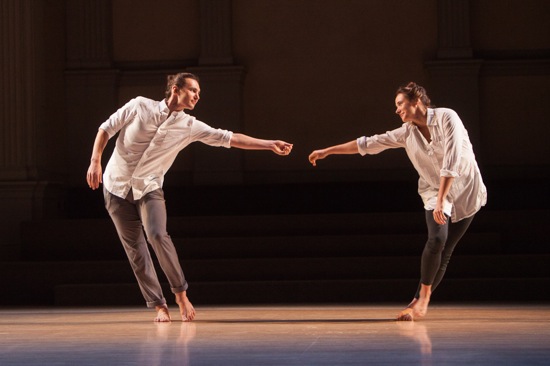Ivy Baldwin Dance at BAM Fisher and Hilary Easton + Co. at Danspace St. Mark’s.
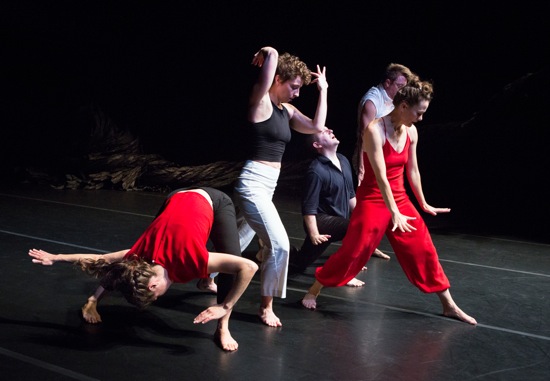
Ivy Baldwin’s Oxbow. (L to R): Anna Carapetyan, Eleanor Smith, Ryan Tracy, Luke Miller (hidden), Katie Workum. Photo: Yi-Chun Wu
Every now and then, I sift through a horde of ancestral photographs, puzzling over how some of the images fit into the structure I call “my family.” Some from the 20th century are impulsive and particular. A solitary child wearing a bib (me) squints at a small birthday cake with two candles on it. Generations earlier, the subjects are posed, dressed in their best. Photographed in front of a generic studio drape and/or a potted palm, my presumed relatives and their friends stare at the camera, trying not to blink while its shutter opens and slowly takes in the scene. And who are the people memorialized in an album of tiny tintypes? School friends? Neighbors? Time has loosened the ties that bound them together.
This thought popped up while I was pondering Ivy Baldwin’s new Oxbow. In it, as in most of her work (she founded her small company 15 years ago), she pieces together images, thoughts, sensations, and memories to create a dance that is both visually clear and profoundly enigmatic. Who are these people moving in and out of BAM Fisher’s performing area? What are they seeing when they stare far into space or slide their eyes around? What makes them join and separate? Their gestures and moves are often compelling, fascinating; unusual or one step away from the everyday into abstraction, these hint at aspects of terrain, physical complications, tottery relationships, or inner stress. At other times, the dancing is as unrevealing and impersonal as those studio portraits I’m remembering—runs, turns, leaps, a leg thrust out to the back. . . .
Baldwin may have been intent on making her structure resonate in some way with the definition of “oxbow” included in the program: “a bow-shaped lake formed in a former channel of a river.” The flow goes on but not here? Geology, I know, interests Baldwin, as does geography. In the beginning of Oxbow, flow is heard but not seen. Composer-performer Ryan Tracy sits at a piano placed in one corner of the three-sided arrangement of seats. At first in the dark, then lit it from the back by a single spotlight, he begins with a pulsing pattern in a tight range in the middle of the keyboard, pitting it with sudden stops. Gradually he thickens the texture, ventures into high notes or deep, growling ones. His overture ends with repeated groups of chords that summon up the dance. Blackout.
When lighting designer Michael O’Connor illuminates the performing area, we can finally get a good look at the remarkable set (the work of Wade Kavanaugh and Stephen B. Nguyen). What could be a huge, dark bundle of twisted roots lies across the rear of the space. Its texture reminds me of driftwood, except that as the whole structure grows higher and more complex, it suggests a fallen tree. During the whole of Eleanor Smith’s opening solo and beyond, Tracy lies face-down, half under the massive “trunk.”
This solo shows just how inventive Baldwin can be. Smith begins by quaking, the tight vibration of her legs seemingly having no impact on her body or the arm she begins to raise and lower. Her eyes are down. She keeps this up for quite a while, and gradually her body loosens and her gestures enlarge in response to the tremor. I think of a volcano, then don’t. Everything she does is intriguing (I should add that she’s quite close to the spectators in this constricted space). Slowly and in silence, Smith kneels and twists her body so she can reach in what seem to be contrary directions. On her feet again, she lunges, deepens that lunge until it looks perilous, and then arches her back to stare upward. As she tries out these and other strained moves, responding to who knows what forces, a quiet rhythmic crackling begins. At first you can’t be sure whether it’s Justin Jones’s delicately atmospheric sound score edging its way in or a heating pipe.
Smith is huddled against the tree when Luke Miller and Anna Carapetyan enter with a very different sort of energy (the terrific Miller replaced Lawrence Casella, who was, sadly, downed by illness after two collaborative years of working on Oxbow). Side by side, these two stride about, kicking their legs in different directions like pointers. Slowly Tracy pulls himself together, and Smith rouses herself. The four have begun to acknowledge one another, when a fifth dynamic enters the scene. It’s Katie Workum, who, clad all in red (costumes by Alice Ritter), streaks in from one of the stage’s four corner entrances, leaping on a diagonal. A swift current (if you’re thinking along those lines). Low, muttery music seethes up, and Workum’s leaps prove briefly contagious. A few minutes later in the hour-long dance, she leaps out one exit, and vaults back in via another.
Over the course of Oxbow, as the dancers collaborate, go their separate ways, or copy one another, they project an awareness of an environment that’s invisible to us—staring around or above the space. Sometimes they appear wary (“what will he do next?”). Certain intriguing moments stand out. Miller, rotates almost robotically in place, clapping his hands together in tiny, sharp moves; Carapetyan sits on the piano bench, doodles a little, then drops her head on the keyboard, before getting up and running with the men. Smith sits down at the instrument and plays low, purposeful, stormy chords. Miller, soloing for a while, keeps stopping with one leg held out in front of him his arms spread like wings, and, maintaining that balance, bends back to look at the space above him. At one point near the end, Workum and Carapetyan connect awkwardly; Workum crawls around her colleague, then tries to make her feet walk up Carapetyan’s body; the two end in a complicated tangle on the floor.
There’s a lot of strenuous movement in Oxbow, but not all of it reveals the atmosphere that I think Baldwin wishes to convey. I also find myself yearning for these highly compelling performers to contact the magnificent decor in more ways, rather than occasionally standing behind it or leaping over it, as Miller does when he finishes his solo and exits (Nijinsky!). At certain points when the dance seems to grind its wheels, I start wondering what it is trying to tell us, and my mind starts to roam. I call it sternly back. I should not be suddenly recalling The Oxbow Incident and cattle rustling just because some of the dancers are walking on their hands and knees around others who are standing.
It is one of Baldwin’s gifts and also one of her liabilities that she can invite us to contemplate what might be a folk tale from a country we can’t remember visiting.
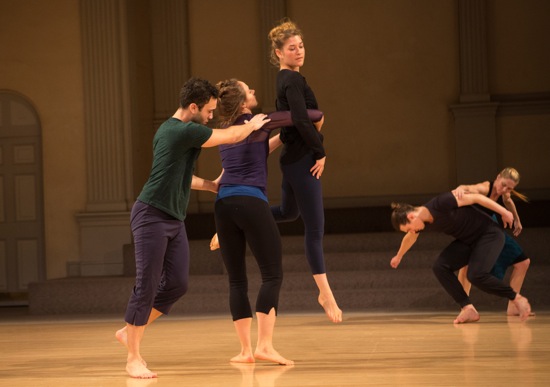
Hilary Easton’s I Am With You. (L to R): Joshua Palmer, Alexandra Albrecht, Jessica Weiss, Michael Ingle, Emily Pope-Blackman. Photo: Yi-Chun Wu
Hilary Easton formed her small dance company in 1992, and this year marks her 20th anniversary of presenting work at St. Mark’s Church, where her sponsor, Danspace Projects, is celebrating its own 40th anniversary. Easton is not a prolific choreographer, but she creates one evening-length work every year or every two years, in addition to teaching and working as a consultant for various prestigious arts education projects. Her choreography is always thoughtful and elegantly structured.
She takes the title of her new I Am With You seriously. In the opening of the first part of the work, she joins her eight company members and five student dancers in forming lines that establish the church’s dimensions. Walking efficiently at a moderate pace, they mark its two diagonals, then line up horizontally, before separating and spreading out over the space. Easton then leaves them to their own devices, while Mike Rugnetta’s taped score adds a second sound to its light ticking.
In unison and without moving from their individual plots of space, the dancers perform a sequence of small, deliberate gestures and shifts of weight and changes of focus (the first move looks as if they’re pulling something out of one thigh with a thumb and two fingers). Then, as they start the sequence over, individuals begin to break off and reposition themselves until all are in a line that stretches from the altar platform to the audience, bisecting the space. A couple more moves bring them into two horizontal lines and a bit of counterpoint.
Now one of Easton’s themes becomes clear. She is asking us to see the differences and commonalities between five experienced dancers, some of whom have been working with Easton for a number of years (Alexandra Albrecht, Michael Ingle, Joshua Palmer, Emily Pope-Blackman, and Jessica Weiss) and five high school students (Jahmir Duran-Abreu, Tara Egan, Zachary Farnsworth, Iris Feldman, and Sidne Norman). The latter, culled from Dalton, Chapin, and Grace Church School range from 14 years old to 17. The two groups take turns performing the same complex sequence, in which the five smoothly move individually and collaboratively within an almost sculptural cluster—one person, say, lifting another and setting him/her down in a new spot, someone ducking under, someone turning to grasp a colleague who has just completed another move, some one rushing to a new partner.
Both the senior and junior quintets perform as if this were an agreeable and demanding job that requires their full concentration. Of course you notice the difference between seasoned professionals and talented up-and-comers, but this is not necessarily a matter of physical skills or aplomb. One interesting thing: the company members make traveling into a new encounter as vital as the big event coming up, whereas the young dancers tend to focus on that more challenging move and let the energy drop on their transitional steps.
The two groups alternate twice more—covering more ground, spreading out, varying their facings before Kathy Kaufmann dims the lights and they all exit. The next section of I Am With You begins with what sounds like someone practicing a guitar in the distance. Four people (Pareena Lim, Joey Loto, Jessica Weiss, and Evelyn Wheeler) occupy the space. The overall rhythm of the choreography is desultory; an individual may pause—perhaps to ponder the next sequence of movement or to check out the others and map the space in his/her mind. Although their focus on their diverse tasks—sometimes big, ground-covering passages, sometimes small gestural details, sometimes a merger of both—stays constant.
The title acquires particular resonance in this quartet. Decidedly, these four are “with” one another. When Weiss walks in a big circle, the other three watch her closely; then all four take off in individual orbits that complicate the space, gradually adding steps that further expand on the basic perambulatory theme. Albrecht and Ingle are also “with” each other in the final duet. Face to face, they talk together inaudibly. As they begin, almost sleepily, to dance side by side, they keep their eyes on each other. Side by side, they built a pattern of spacious dancing, seemingly to accumulate steps as they go.
However, what they are not “with” is the recorded music that accompanies them: the magisterial Prelude and Liebestod from Richard Wagner’s Tristan and Isolde. The words that Isolde sings over her lover’s dead body just before her own suicide bespeak hopeful delusion; he cannot be truly dead—did his eyelids not just flutter? Whether or not you know the gist of the music, you can drink in the richness and temperamental surges of the orchestra, the waves of passion.
Although Ingle and Albrecht, in their closeness, could stand for Wagner’s ill-fated pair, and at one point they sit, seeming to listen to what may be final chords of a musical passage, they nevertheless steadily pursue their dancing and their interest in each other without yielding to the emotional tempest washing over them or following the music’s phrasing. The effect is curious, even disturbing. Afterward, I think about the act of playing a CD while doing small, demanding tasks. Does the music soothe or temper you without undercutting your accuracy? Hard to say. I think if I heard the Liebestod right now while I’m still writing these words, I’d need to get up from the chair and put my arms around my husband. Maybe that’s part of what Easton is driving at. Or maybe she’s thinking that dancing is one way of putting death out of your mind.

